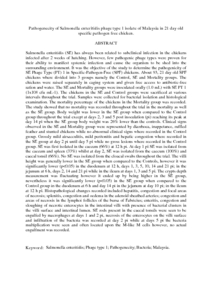Citation
Ahmad, S. and Bejo, Mohd Hair and Zakaria, Zunita and Bejo, Siti Khairani
(2011)
Pathogenecity of Salmonella enteritidis phage type 1 isolate of Malaysia in 21 day old specific pathogen free chicken.
Journal of Animal and Veterinary Advances, 10 (10).
pp. 1355-1363.
ISSN 1680-5593
Abstract
Salmonella enteritidis (SE) has always been related to subclinical infection in the chickens infected after 2 weeks of hatching. However, few pathogenic phage types were proven for their ability to manifest systemic infection and cause the organism to be shed into the surrounding environment. It was the objective of the study to determine the pathogenicity of SE Phage Type (PT) 1 in Specific-Pathogen-Free (SPF) chickens. About 93, 21 day old SPF chickens where divided into 3 groups namely the Control, SE and Mortality groups. The chickens were raised separately in caging system and given free access to antibiotic-free ration and water. The SE and Mortality groups were inoculated orally (1.0 mL) with SE PT 1 (1x108 cfu mL-1). The chickens in the SE and Control groups were sacrificed at various intervals throughout the trial. Samples were collected for bacterial isolation and histological examination. The mortality percentage of the chickens in the Mortality group was recorded. The study showed that no mortality was recorded throughout the trial in the mortality as well as the SE group. Body weight was lower in the SE group when compared to the Control group throughout the trial except at days 2, 3 and 5 post inoculation (pi) reaching its peak at day 14 pi when the SE group body weight was 26% lower than the controls. Clinical signs observed in the SE and Mortality group were represented by diarrhoea, inappetance, ruffled feather and stunted chickens while no abnormal clinical signs where recorded in the Control group. Grossly mild airsacculitis, mild peritonitis and hepatic congestion where recorded in the SE group at day 2 pi until day 5 pi while no gross lesions where recorded in the Control group. SE was first isolated in the caecum (66%) at 12 h pi. At day 1 pi SE was isolated from the caecum and spleen (33%) whilst at day 2, SE was isolated from the caecum (100%) and caecal tonsil (66%). No SE was isolated from the cloacal swabs throughout the trial. The villi height was generally lower in the SE group when compared to the Controls, however it was significantly lower (p<0.05) in the duodenum at 12 h, days 1, 3, 5, 10, 14 and 21 pi; in the jejunum at 6 h, days 2, 14 and 21 pi while in the ileum at days 1, 3 and 5 pi. The crypts depth measurement was fluctuating however it ended up by being higher in the SE group, nevertheless it was significantly lower (p<0.05) in the SE group when compared to the Control group in the duodenum at 6 h and day 14 pi in the jejunum at day 10 pi; in the ileum at 12 h pi. Histopathological changes recorded included hepatitis, congestion and focal areas of necrosis; splenitis, congestion and oedema in the adenoid sheathed arteries; congestion and areas of necrosis in the lymphoi follicles of the bursa of Fabricius; enteritis, congestion and sloughing of necrotic enterocytes in the intestinal villi with presence of bacterial clusters in the villi surface and intestinal lumen. SE rods present in the caecal tonsils were seen to be engulfed by macrophages at days 1 and 2 pi, necrosis of the enterocytes on the villi surface and infiltration of the bacteria was recorded at day 2 pi while at days 5 pi the bacteria multiplication were seen and often located upon the M-like M cells however, no actual engulfment was recorded.
Download File
![[img]](http://psasir.upm.edu.my/25363/1.hassmallThumbnailVersion/Pathogenecity%20of%20Salmonella%20enteritidis%20phage%20type%201%20isolate%20of%20Malaysia%20in%2021%20day%20old%20specific%20pathogen%20free%20chicken.pdf)  Preview |
|
PDF (Abstract)
Pathogenecity of Salmonella enteritidis phage type 1 isolate of Malaysia in 21 day old specific pathogen free chicken.pdf
Download (87kB)
| Preview
|
|
Additional Metadata
Actions (login required)
 |
View Item |

